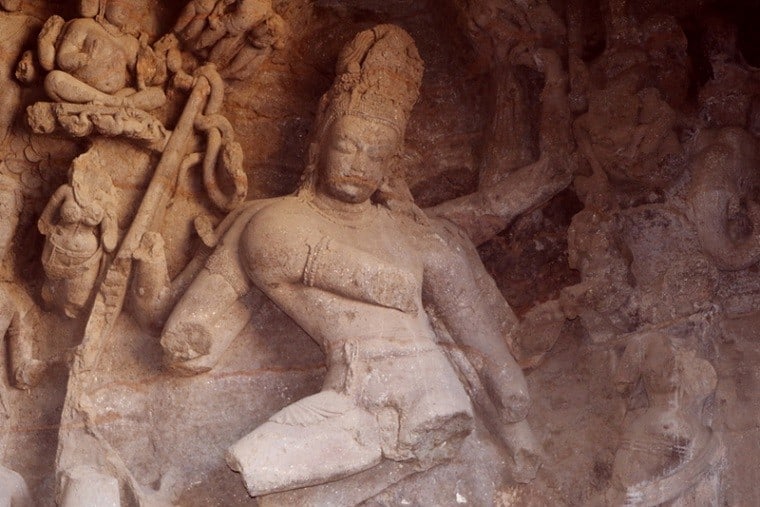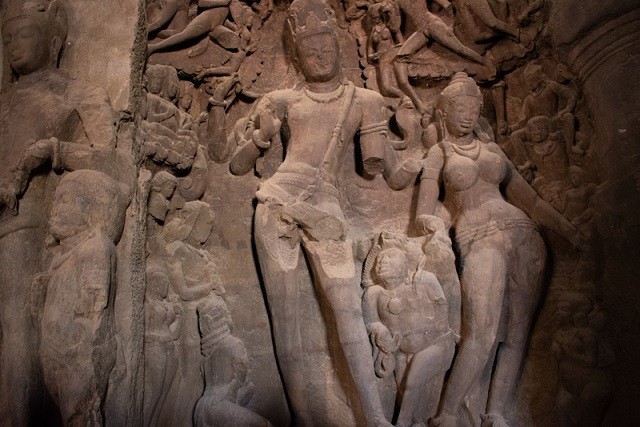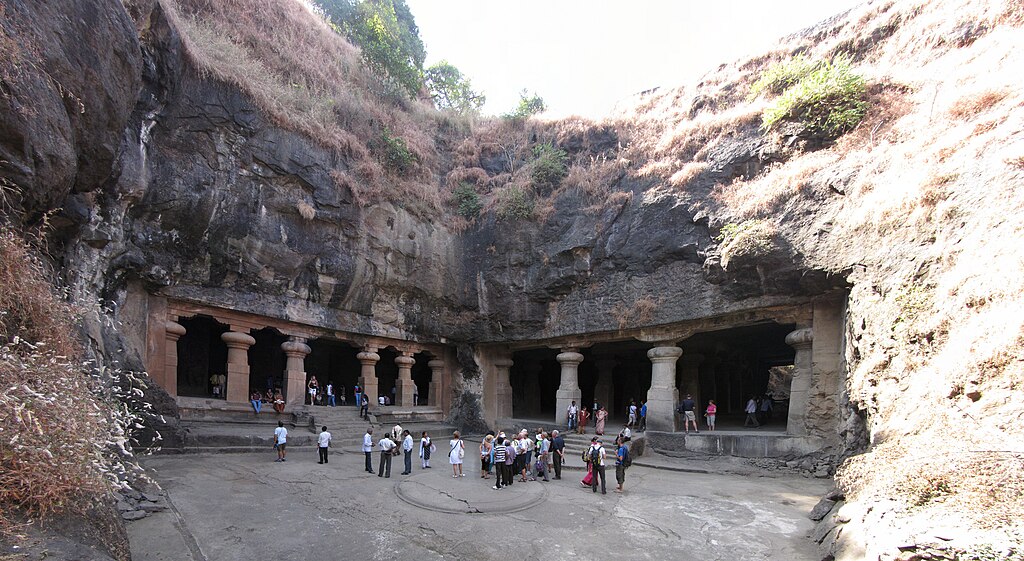Mumbai, the business capital of India, is known for its tourism. There are many historical monuments and sculptures in Mumbai that people visit to see while on vacation.
One such place is Elephanta Caves, located on an island just off the coast of Mumbai city. These caves were built between the 5th-7th century AD by Hindu kings.

The structure of these caves shows the perfect blending of the Dravidian and Nagara styles of Hindu architecture.
This blend makes it one among a few temples with two different styles of temple building existing side by side. It was initially called Gharapuri, but later it became popularly known as ‘Elephanta.’
The world heritage site is dedicated to Lord Shiva and has some fascinating rock-cut architecture and statues dating centuries back.
History of Elephanta Caves
The Elephanta Caves are situated in the middle of Mumbai Harbour, off the coast of Mumbai. Three different names knew the island during ancient times.
It was called Gharapuri or Gharapur Island, which means City of Caves, Sonapuri, and Elpata. The ancient Indians believed Shiva established his lingam at this site and created a new era – the ‘Shanivar era.’
Two teams worked on Elephanta caves in its long history- one during the 5th century and another before the 15th century. Most of it is attributed to the former team, who have found more proof for their work than others.
During the Mauryan dynasty, in the 5th century, the two brothers, Manku and Charanku, worked on this site. They were responsible for creating rock-cut temples here, called Caves 1 to 6.
Historians believe they belonged to a non-Aryan tribe called ‘Mallas’, who ruled over large parts of ancient India from the 6th century BC to the 12th century AD.
The second team was probably from outside Maharashtra. Historians have found evidence suggesting that people of Konkan used to call themselves ‘Konkana.’ This word resembles the Kannada language where ‘Ko’ means same while ‘na’ means land.
Hence, Ko-na-nak-desa gives Konkan. Historians believe that the second team probably belongs to the Kannada-speaking Kanarese people, who were responsible for reviving the ancient glory of Elephanta by making new shrines and sculptures in the 10th century.
Facts about Elephanta Caves Architecture
Architecture: The Elephanta Caves are a group of rock-cut temples that were excavated to reveal five different temples dedicated to Lord Shiva that can be found at this site along with other deities like Ganesha Vishnu, Surya, Ravana, and Durga.
They also have images engraved on these walls depicting Indian mythology scenes resembling those seen in cave paintings from Ajanta and Ellora.
Besides these, several other sculptures depict gods, goddesses, and demons. There is also a shrine dedicated to Lord Ganesha in the three caves carved out from massive basalt rock.
What visitors can get to see in the Elephanta caves
Visitors who visit this place will see as many as seven temples built between 500 and 1050 A.D.
People can also go boat riding on the backwaters of Mumbai, near the island where these caves are located. This place also has a museum that houses the famous Elephanta sculptures and artifacts.
Statues depicting three different deities, Ganesha, Vishnu, and Shiva, have also been excavated in this place, along with a shrine that houses a seven-faced Sadashiva deity in a central shrine inside the main temple.
A Nandi bull sculpture can also be seen in one of these caves. People who visit this place should not miss seeing all these beautiful art pieces.
Which statues and sculptures are found in the cave, and what is their importance
Elephanta Caves, a UNESCO World Heritage site and a significant tourist spot in Mumbai, houses rock-cut Hindu sculptures. It also houses a group of inscriptions written in Brahmi script from the first century BC.
The carvings depict Lord Shiva as Mahayogi, dancing Lord Nataraja and Gangadhara. These sculptures are life-sized, realistic figures carved out of one piece of rock with detailed finishing added later, as evidenced by the shikaras (decorative tops), which were only added later.

The Statues found in the cave include:
Goddess Mother Earth
The sculpture is from the Gupta period from the 5th century AD. This statue shows a goddess who is seated on an elephant. She has four arms, and two of her hands are broken.
Sun and moon emblems at her headstand for time and death, respectively. She is believed to hold a plough, a conch shell, a tree shoot, a turning wheel, and a lotus flower in each of her hands to signify fertility, prosperity, and righteousness, respectively.
The goddess also has several animals beside her, like peacocks, etc.
The Siva Nataraja
This statue represents Lord Shiva as the cosmic dancer of creation and destruction.
It was built during the 10th century AD by a Pallava king and is a masterpiece of Indian art. Lord Shiva’s right leg is raised and bent at the knee, and the left hangs low, with his head turned back, and eyes closed in meditation.
He holds a small drum shaped like an hourglass which represents time. A tiny statue of a bull stands behind him as he dances on the demon of ignorance called Apasmara Purusha, who personifies ignorance, laziness, or forgetfulness that makes one ignore spiritual practices.
Horse-Shaped Capital from Aihole
Chalukya king Mangalesha made this pillar capital from AD 543 to 568 AD. It resembles a horse’s head with a sharp beak-shaped structure below it. This structure has been used as a support to tie horses.
Elephanta Caves Architecture
There are no ornate carvings and statues that we see in Ajanta or Ellora, but the cave architecture of Elephanta is even more impressive.
It looks like a fort, with massive walls surrounding it, and the only entrance/ exit to the caves is through narrow steps cut out of rock which can be approached by crossing a bridge over water.
The huge statue of Ganesha has beautifully carved pillars and two smaller temples.
Sculptures include Lord Vishnu, Durga slaying Mahishasura, Lingodbhava (a representation of Siva emerging from an opening lingam), and so on.
Siva Nataraja’s sculpture is the best example of Chola Art in North India. It represents Lord Shiva as the cosmic dancer who performs his divine dance to destroy ignorance.
The other sculptures for which Elephanta Caves are famous include Trimurti (a three-headed bust of Brahma, Vishnu, and Siva), Ardhanarishvara (half male and half female – Man-Lion), Harihara (half male, half female representing Siva with wife Parvati), Mahesamlokha (Lord Shiva depicted in a fury with numerous arms) Gajalakshmi (a bust where Goddess Lakshmi appears on a lotus leaf emerging from water), etc.

Goddess Mother Earth sculpture is from the Gupta period from the 5th century AD. It shows a goddess seated on an elephant with four arms and two hands broken.
She holds a plow, a conch shell, a tree shoot, a turning wheel, and a lotus flower in each of her hands to signify fertility, prosperity, and righteousness, respectively.
Chalukya king Mangalesha made Horse-Shaped Capital from Aihole from AD 543 to 568 AD. It represents a supporting structure for tying horses.
Elephanta Cave architecture consists of massive walls surrounding it with narrow steps as entrance/ exit across water surrounded by caves cut out of rock that look like forts.
Elephanta is a world heritage site that comes under the protection of the Archeological Survey of India.
How to reach Elephanta Caves in Mumbai
The nearest airport is Chhatrapati Shivaji International Airport at Sahar, about 16 km away. Besides this, another closest option would be Juhu Aerodrome which lies only 7km from the site.
Buses run by BEST ply from CST station and Swargate bus stand, plying towards Alibag. The caves are located a little away from the main road in Gharapuri or Elephanta Island. Tourists can hire taxis to go to this island from the CST station.
There are boat services from the famous Gateway of India too.

The best time to visit Elephanta Caves in Mumbai
The best time to visit the caves would be from October to June when it remains relatively cool and dry. The humidity levels during this time remain conducive enough for exploring the place.
Tourists should avoid visiting between July – and September because heavy rainfall makes most parts of the island inaccessible.
Since the island is surrounded by sea, tourists may face problems visiting places around Mumbai. If you plan to visit in the monsoon season, carrying an umbrella with you would be wise.
However, people can also explore these caves around the year but should check whether the ferries are operational before planning a trip.

Entry fees and visiting timings at Elephanta Caves in Mumbai
The entry fee for Indian visitors is Rs 40 per head, while a ticket for foreign nationals will cost Rs 600. No entry fee for children below 15 years of age.
The caves are open from 9 am to 5 pm every day, except on Monday when it is closed. However, the timings may vary slightly depending on the weather conditions, so tourists need to check before visiting.
Elephanta Caves Mumbai Timings
| Day | Timing |
|---|---|
| Monday | Closed / Holiday |
| Tuesday | 9:30 am – 5:00 pm |
| Wednesday | 9:30 am – 5:00 pm |
| Thursday | 9:30 am – 5:00 pm |
| Friday | 9:30 am – 5:00 pm |
| Saturday | 9:30 am – 5:00 pm |
| Sunday | 9:30 am – 5:30 pm |
Things to remember when visiting Elephanta Caves
- Make a plan for your trip, bearing in mind the ferry times.
- Guided tours of Elephanta Caves are available with licensed guides only.
- Beware of monkeys; store food items in your bag.
- Drink plenty of water.
- Put on comfortable shoes.
- Wear your sunglasses and hat.
- Use sunscreen cream.
Some other caves in Mumbai
Besides the Elephanta Caves, there are several other caves in Mumbai.
The earliest is Kanheri Caves near Borivali, built during the 1st century BC and contained Buddhist Stupas, shrines, and sculptures. Carved during two phases – 150 AD to 600 AD, the second phase has a better artwork quality than the first. The carvings are so well history because they have been exposed to outside conditions for the past 1800 years.
Another set of rock-cut caves is located on Elephanta Island in Mumbai harbor. There are three main groups of cave temples dating back to around the 6th century AD. The island’s town was called Gharapuri, which became corrupted into Elephanta or Elpata.
The rock-cut temples of Ellora were dug side by side in basalt cliffs. Construction started in 600 AD and continued for the next 300 years. There are 34 caves here, of which 12 are Hindu, 17 Buddhist, and 5 Jain temples. The best known is the Kailash Temple, dedicated to Shiva.
Other famous historical monuments near Mumbai are Karla Caves, Bedsa Caves, and Kanheri Caves.
According to some accounts, Bedsa Caves date back to the 2nd century BC or earlier. They were re-discovered in 1819 by Captain John Smith during one of his hunts for treasure allegedly buried at ancient Buddhist monasteries by foreign invaders like Alexander the Great etc.
The Karla Caves were built between the 1st century BC and the 10th century AD. They are also known as Kanheri-Karla or Kala-Kachha caves. The word “khal” means “window,” and the shape of these rock-cut structures has led them to be called so. These caves have several Buddhist Stupas, which were enlarged in the later period. The first excavation happened around 170 AD, but significant work started in the 1st century AD and continued till the late 5th century AD.
Famous Places Nearby:
Mount Mary Church Bandra – The Basilica of Our Lady of the Mount, commonly known as Mount Mary Church, is a Roman Catholic Basilica in Bandra, Mumbai. Even though the church tower is 100 years old, the history of the current statue of Our Lady dates back to the 16th century when Jesuit priests from Portugal got the figure to the present place and built a chapel.
Girgaon Chowpatty – The Girgaon Chowpatty Girgaon Chowpatty Beach can be a local spot to explore and the most famous beach in Mumbai. The beach is a popular destination for massages, yoga, and strolls at a leisurely pace.
It’s also a popular spot for those looking to relax with their family and friends after work. You can relax on the beach, sipping hot tea, bhelpuri, and panipuri while watching the sunset on the Arabian Sea.
Chhatrapati Shivaji Terminus – Chhatrapati Shivaji Maharaja Terminus is one of the most important railway stations connecting Mumbai with other national regions. In addition to its importance in the commercial world, It’s a landmark structure constructed in the Victorian-Gothic style.
It was previously known as Victoria Terminus. British engineers and Indian artisans worked for a decade to construct this structure.
Gateway of India – This stunning stone arch overlooked the Arabian Sea and was built to commemorate the first visit by King George V and Queen Mary. It is among the most popular spots for a visit to Mumbai for the people of Mumbai who visit to stroll around or watch the ferries that enter and leave the harbor.
It is also known as the Gateway of India and is the location for many luxurious boat excursions. It is a must-visit location for any Tourist who comes to Mumbai.
Taj Mahal Hotel – The most famous and Prestigious luxurious Taj Mahal Hotel is situated opposite the structure of the Gateway of India.
Marine Drive – Another famous attraction in Mumbai where you can sit beside the sea or walk on the promenade. It’s where you will see couples, Children, and early morning walkers enjoying the fresh sea breeze.
Chhatrapati Shivaji Maharaj Vastu Sangrahalaya – is around 5 km from Marine Drive.
Jehangir Art Gallery – is a famous art gallery only 5 km from Marine Drive.
Flora Fountain – in Fort is another famous structure between Marine Drive and the Gateway of India. It is just a water fountain with an exciting history and landmark in Mumbai.
Summary:
Elephanta Caves is a series of monolithic basalt rock-cut structures comprising five Hindu caves on Gharapuri or Elephanta Island.
These stone-cut temples and shrines were carved out during the reigns of different dynasties, from the phase starting Mauryas followed by the Chalukyas, Rashtrakutas, and Yadavas.
The most popular of these caves that have gained greater attention include Shiva as Nataraja (the cosmic dancer), Shiva slaying Andhaka (Shiva’s son), Lord Shiva with consort Parvati, Ravana trying to lift Mount Kailash (home of Shiva), and the marriage of Shiva and Parvati.
Besides these, several other sculptures depict gods, goddesses, and demons. There is also a shrine dedicated to Lord Ganesha in the three caves carved out from massive basalt rock. The best time to visit the Elephanta Caves in Mumbai is from October to June; it remains relatively cool and dry.



Leave a Reply